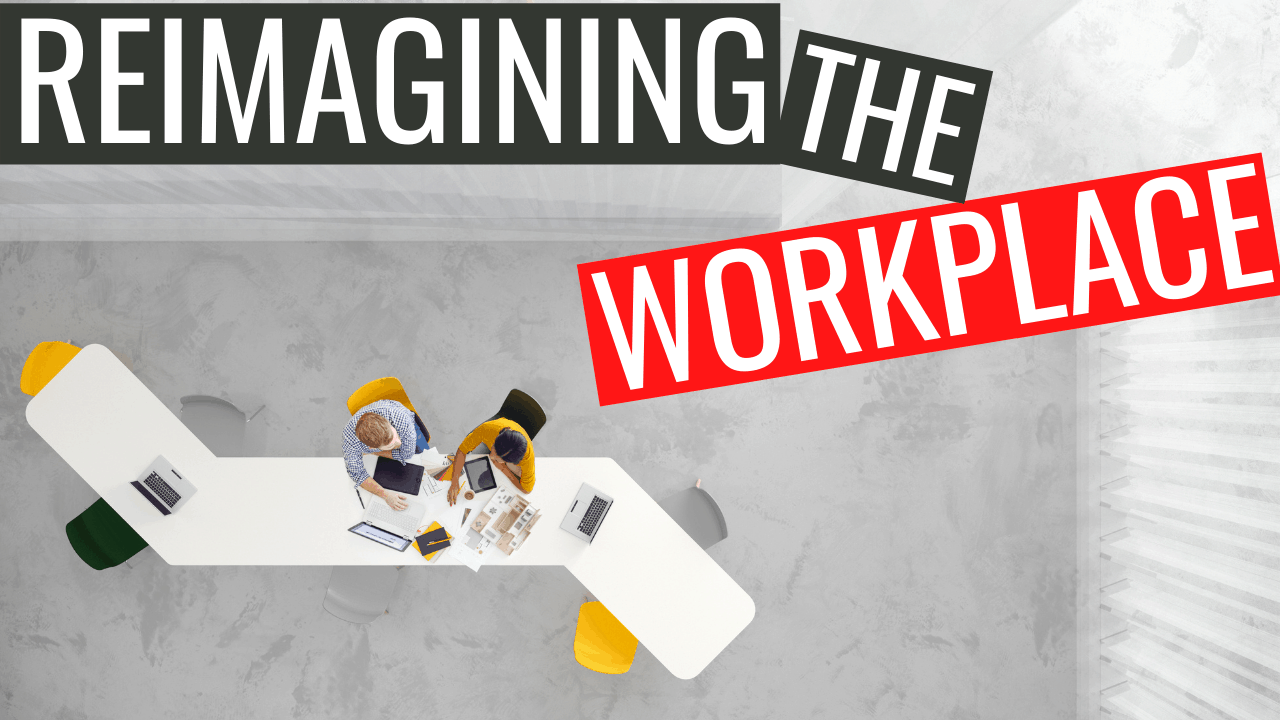While the technocrats of this world create hype around AI to keep technology centre stage – in the spotlight for the future of work – let’s not be too hasty in handing over control of the henhouse to ravenous foxes. The reality is that the value of people outstrips that of machines by a considerable distance, and we have the numbers to prove it.
Crisis consumes a leader’s attention, and this has never been more apparent than with the global pandemic. We have had little time to think of anything else but the steps we needed to take to ensure the safety of our people, keep the lights on and the doors open. This laser-like focus on tactical survival means many of us may have missed the strategic story of last year: In 2020, employees’ relationship to work changed fundamentally and forever. There is a new paradigm emerging – the human workplace – and leaders need to pay attention.
Over the next five years, the global investment in human talent will be $1.2 quadrillion. To put such a large number into perspective, that is 2.33 times as much as will be invested in technology, real estate and all other physical capital combined. Unfortunately, C-level executives seem to be much slower to grasp the implications of people trends than they are of changes in business models or technologies. This is not just about telecommuting. The greater change is where companies are going culturally, and digital technology is not, and never will be, a substitute for human connection. A larger evolution is creating new kind of workplace – the human-centred workplace.
Work is changing across multiple dimensions simultaneously. Business processes are being dismantled, disrupted, torn apart, and rearchitected in response to profound changes in technology and society. Ideas such as agile transformation were once the specialised proposals of visionaries. Now, entire corporations are remodeling themselves on these principles. As artificial intelligence takes on heavy cognitive tasks, and robots replace human muscle, these transformations put a premium on our most human of qualities. Problem solving, collaboration, learning and creating all depend on solid relationships and excellent communication. When people trust each other, they take risks together. When employees build bonds of appreciation, caring and mutual respect, they are free to break the psychic boundaries of bureaucracy.
“When an organisation makes the decision to value the individuality of its employees, it is not only the employees who win – the system wins, too, and wins bigger than ever.”
― Todd Rose
The New Work Paradigm
A crisis can also clarify essential truths that leaders might have lost in the fast-paced routine of business-as-usual. Companies are built on relationship infrastructure. When that weakens, their culture begins to decay. During the pandemic, the key moments of relationship-building (hiring, onboarding, teamwork, mentoring) by necessity became remote. This means the hundred little gestures of connection that we took for granted each day evaporated. From serendipitous meetings at the water cooler, to reading the body language of a colleague during a team meeting.
As we return to our workplaces, we need to restore our relationships. The best way management can do this is to empower employees to teach and motivate each other. In this way, we can use technology to spread positive emotions – recognition, celebration and sharing – throughout the organisation. Recognition is the currency of human connection. When people feel valued, appreciated, recognised and empowered, they respond with greater energy and engagement. When you create a culture of appreciation, people invest more of themselves in their work. Recognition is the heart of a reimagined workplace because it shows people the significance of their actions. People crave authenticity and acceptance. They want to feel safe, energised, and valued by the community that is their workplace.
“Sometimes you have to get LOW before you can go HIGH. Humility is the first step. You will reap the prosperity of your adversity.”
― Jentezen Franklin
The Path to Prosperity
Global leaders like Apple, Tesla and Zoom design the customer journey through an emotional experience. Design matters in human resources just as much as software or cars. This means your organisation’s success requires a company culture in which everyone is passionately engaged, empowered, and united by common values. To design this kind of culture, leaders must recognise three vital truths from the last decade:
1. Leadership has evolved permanently from command-and-control to autonomous, self-governing teams. Employees know what they want and insist that companies honour their values.
2. The workplace is the “new community”. Business is society’s most trusted institution. For many of us, the workplace is a safe haven of united purpose and shared values in a polarised society.
3. We must harness our humanity to move ahead. During the pandemic, the best of our performance was shown in empathy, creativity and innovation. We can never unsee the power of humanity at work.
Because business is more trusted than government, media, schools and other institutions, employees believe that organisations are best positioned to influence the course of society. The Edelman Trust Barometer found that 68% of employees believe CEOs should lead on issues like income inequality and the ethical use of data. Authentic connection binds a community most effectively when people appreciate and respect each other. In the reimagined workplace, people of all kinds are recognised and honoured for bringing their whole hearts and minds to the job. Business as a force for good, and good as a force for business.
“They always say time changes things, but you actually have to change them yourself.”
― Andy Warhol
The Future of Payroll
The global pandemic was a crash course in agility for organisations of all sizes. They innovated, they improvised, they were quickly brought up to speed in virtual practices, and nimble new decision-making processes were invented. Those lessons won’t be unlearned. As we return to our workplaces, we are quickly realising that the way we work moving forward has changed faster than anyone anticipated. Yet, for all the changes in work methods, the structure of compensation plans has not changed in what feels like eons. Economic stress is one reason: Data from the Society of Human Resource Management shows a 34% reduction in pay increases since 2019 and Korn Ferry’s Global Salary Survey shows that only 35% of survey participants are making 100% of their workforce eligible for a raise this year.
There is a gloomy sense amongst workers that they are, at best, treading water or going backwards. This means it’s time to make payroll just as agile as other work. Agile pay could mean that anyone could give and receive micro-bonuses throughout the working year. Agile pay could recognise individuals and interactions, not just rules or outcomes. It could reward people based on creating value in any way that benefits the customer or the organisation. Structuring a pay program on individual bonuses alone can produce negative outcomes by eroding team spirit. When everyone’s competing for a piece of the same pie, they become reluctant to share information freely, boost their teammate’s productivity, or step in to contribute in ways that will not directly affect their KPIs. Trust and innovation suffer. Growth, agility and teamwork decline.
Traditional compensation systems (salary, bonus, annual increase) haven’t moved the needle on performance for decades. They are the smouldering remains of command-and-control management and they are in desperate need of a re-design, based on a simple fact: the people closest to the work are best suited to rate performance. By contrast, PayScale found that top performing organisations are more likely than others to offer a wide range of incentives, using compensation plans, with as many as 10 components. Some are monetary (salary, bonuses) and some are non-monetary items like career development, paid time off, flexible schedules and recognition. An individual mix of components can be adjusted to suit what individual employees most value – which is not always money.
“Mediocrity knows nothing higher than itself but talent instantly recognises genius.”
― Arthur Conan Doyle
Recognition Creates Community
In the reimagined workplace, compensation can be fair and flexible. Agile pay is not simply determined by who has the most refined resume, or the most sought-after skill. It also includes a portion of pay that is rewarded by peers to peers, for all kinds of performance. Using 1% or more of payroll funds, peers can reward each other for great performance, symbolically highlighting values like customer focus, innovation, integrity and empathy. Agile pay is like agile management: it’s empowering, decentralised and it opens up the possibility of surprise. This kind of recognition system spreads the word about which behaviours are demonstrated and celebrated throughout the company culture. A social recognition system is the enabling technology of agile compensation. Several factors make social recognition the ideal tool for agile pay:
1. Recognition is more discerning
Recognition is more discerning than a bonus program which is based solely on bottom-line results. How can key performance indicators, like revenue targets, be exacting enough to measure the contribution of the person who coaches a new team member, or the person whose creativity drives the team to go above and beyond? Only the direct witnesses can do this.
2. Recognition is individual
Managers cannot be everywhere at once. Co-workers know who came up with the innovative idea, who spent extra time on a project, who supported a team member stressed out by having to do their job while home-schooling a child during the pandemic. In gratitude and recognition for these “above and beyond” actions, peers can make a public accounting of those meaningful moments, accompanied by a micro-bonus (typically in a points-based program). Cha-ching!
3. Recognition is more immediate
Annual bonuses typically reward good work as much as a year down the track. A compensation deal made at the beginning of any given year cannot possibly anticipate all the challenges and accomplishments of the year to come (2020 showed us just seen how extreme the difference between anticipation and reality can be). More managers are moving from the annual performance review to continuous feedback and coaching as the working year unfolds. Pay in the form of recognition moments is powerful, specific feedback.
“If you want it to happen, measure it. If you
want it to be repeated, recognise it.”
― H. J. Chammas
Agile Performance Management
Traditional performance management is woefully outdated. No employee looks forward to a tedious hour reviewing the past year. And no manager relishes the thought of preparing a dozen documented performance review sessions. We need to move past the box-ticking mindset and redefine performance management through human connection. Growing your people needs to become an agile process, in the sense of agile values and methods – like putting people at the centre of business decisions where they can more quickly experiment with processes and more readily collaborate with customers.
An agile performance management system is always-on, meaning employee data and sentiment is constantly streamed into the system. This helps to aid decision-making and uncover issues before they become a big deal. If you’re trying to be “agile” but data is only collected on occasion, how exactly are you agile? This collaborative approach is about continuous feedback and making sure that people are constantly aware of how they are doing as well as what they can do to improve. In this way, all managers and peers communicate goals, set priorities, and detail how work was completed successfully. Any employee can note, in the moment: great performance, achievement, development opportunities or even coming challenges to be handled proactively. Managers can’t be everywhere, so written peer-to-peer appreciation, and analysis of that data, is invaluable.
“When rewards ignore individual performance, the incentive to strive for excellence is lost.”
― Frank Sonnenberg
Crowdsourced Performance Reviews
Agile performance management has four pillars: Continuous learning, frequent check-ins, building trust, and connection to the workplace tribe. In his new book Think Again, Adam Grant writes, “Leaders commonly say, ‘We only hire A players. We don’t tolerate B players.’ The reality is that B players can become A players if you treat them in a way that makes them feel truly grateful.” Agile performance management creates A players through a continuous cycle of positive interactions among employees, managers and executives:
- Coaching and collaboration between manager and employee
- Observing and highlighting the right behaviours
- Recognising the best actions, values, and attitudes immediately and publicly
- Building community and belonging
All of these interactions require equal reciprocity through trusted two-way human connections. This is pretty much the opposite of the old command-and-control idea in which a manager writes a yearly, backward-looking assessment of how the employee is doing. Continuous, meaningful conversations among managers, peers and executives provides a new model for the reimagined workplace. A Harvard study found that frequent, regular check-ins with managers improved performance, which is no surprise. The study’s truly amazing finding was that the conversation didn’t have to focus on a particular task or skill. Just having any interaction – an informal conversation about family or the weather — lifted performance. That’s the power of interaction.
“In modern society we often try to separate our personal and professional life. But this separation needs to be erased. People work better when they are accepted for who they are, living as a whole human being.”
― Abhijit Naskar
Human Metrics Matter
Objectives and Key Results (OKRs) are a legacy of industrial-age quantification. They are obsolete in a constantly changing environment. Conscious leaders are transforming company culture to encourage risk-taking, innovation, new processes, boldness, questioning, integrity, persistence, creativity, accountability, flexibility and more. It’s not a question of lowering standards (you can achieve six sigma quality in an agile environment.) It is a question of rejecting bureaucracy in favour of human values, with all their diversity and surprises.
OKRs assume that you know today what you’ll need six months from now – an idea that was already becoming obsolete before the pandemic. So what metrics matter now? The next metrics will connect behaviour with results, recording what happened as well as how it happened. In an environment of constant change and adaptation the key to understanding what makes the bottom line happen is narrative. For example, why does one department have twice the turnover rate as another, costing a fortune in hiring and retraining? Why is one group innovative? OKRs won’t answer these questions, but a growing narrative of recognition moments, analysed with natural language processing, will.
“We hurt no one when we encourage them to keep on keeping on,
to not give up, to recognise how far they’ve come.”
― Cathy Burnham Martin
Big Things are Often Just Small Things That are Noticed
The most valuable feedback is recognition that someone has just made a positive contribution to the work, whether that’s closing a great sale, streamlining a process, solving a problem or helping a struggling teammate. Any employee can recognise another as long as they are specific, publicly noting what someone did, why it matters and who benefits. Capture thousands of these moments in a database and you write a narrative of activity that is the real record how work gets done. Now we occupy a work world in which it’s possible to record every keystroke, every minute of attention, and the physical comings and goings of every person. Work is a place (in person and online) of relentless data-gathering. In other words, what gets done gets measured and vice versa.
Our technical capabilities can outrun our wisdom, and ubiquitous data-gathering raises serious issues of privacy for employees and ethicists to address. However, there is a positive side to knowing what’s really going on in our workplaces: If leaders put humanity at the centre of management then data analysis becomes a tool that enables our most human qualities to flourish. This is an urgent task. Unique human abilities like collaboration, creativity, empathy, adaptation, and imagination are today’s keys to success. We need to measure the behaviours and interactions that lead to success, and then encourage, celebrate, and reward them. We need to train people to harmonise their differing strengths. We must configure our teams to help people with diverse skills work well together.
“Too often we underestimate the power of a touch, a smile, a kind word, a listening ear, an honest compliment, or the smallest act of caring, all of which have the potential to turn a life around.”
― Leo Buscaglia
Empathy is a Business Tool
The disruptions of the past year demanded agility and resilience from employees. The ways in which we showed up to preserve our businesses highlighted two gateways into human culture: the outward skill of empathy, and the inward experience of belonging. Empathy is the capacity to understand how others experience the world. It’s a powerful business tool both inside and outside an organisation. When product teams have empathy for customers, they design better products. When team members intuitively understand the special struggles of a single parent working from home, they can adjust their routines to help their colleague stay engaged. Leaders showed empathy last year when they said, “This is tough; we will get through this. YOU will get through this and we’re all going to help each other.” By summoning empathy across the organisation, leaders enlisted all employees to look after each other. Remote work has made this “delegated empathy” more important. It’s every leader’s job to highlight this in 2021 and beyond.
When you weave empathy into everyday culture, people relate with their hearts, and their minds open to new ways of working. They connect with customers and each other with greater urgency. Key cultural artifacts of empathy include giving and receiving thanks, celebrating successes, supporting colleagues who need help, sharing positive emotions and seeing each other as individuals. It doesn’t need to be elaborate either: A Workhuman survey found 60% of employees think a simple “thank you” makes their workplace feel more human. We can connect those actions to business results and add them to business processes.
“You will never gain anyone’s approval by begging for it.
When you stand confident in your own worth, respect follows.”
― Mandy Hale
5 Ways To Promote Respect in the Workplace
Any business that does not promote an environment of mutual respect is simply asking for employee turnover. A consistent lack of appreciation and common courtesy is only going to keep your HR team busy managing a revolving door of new hires and disgruntled exits. Word will get around quickly, as it always does, and your brand’s reputation will take a serious hit. As with any other business priority, instilling a shared value of respect starts at the top. Leadership must consistently demonstrate what it looks like to show respect across the entire org chart. A key component of the process, as Aretha Franklin famously suggested, is to “find out what it means” to your workers. In addition to gaining clarity on how different people perceive and receive respect, there are a few steps you can take to foster a respectful atmosphere.
1. Conscious Communication
Catch your employees doing things right. Praise lavishly in public, and critique sparingly in private. Try not to go overboard on either side of that equation, but don’t be slow to share well-earned kudos. Set the example of what it looks like to have a positive disposition, be supportive and show gratitude for a job well done.
2. Prioritise Soft Skills
Hire someone with obvious soft skills – emotional intelligence, self-control, adaptability – rather than a candidate with superior qualifications who rides roughshod over others. Maintaining respect in the workplace becomes exponentially simpler when you filter out selfish, immature people at the front end. Scanning an applicant’s digital footprint (especially their social media feed) is one simple way to assess the degree of respect they show to others. Having more than one set of eyes on an applicant as they interview is another.
3. Resist All Forms of Exclusion
Keep an eye on cliques forming within the workplace. When employees begin to segregate themselves based on job description, seniority or any other criteria, it can quickly give rise to an erosion of trust. Consider holding brief, informal morning meetings to improve communication. Whatever you can do to break down silos will help foster mutual respect.
4. Clearly Articulate Zero Tolerance for Harassment
Studies have shown that approximately 60% of workplace misconduct goes unreported. The most common reasons for underreporting are: a fear of not being believed, the prospect of retribution if the report is not upheld, or the belief that management doesn’t truly care. Any workplace that does not take a firm stand against all forms of employee harassment represents a lawsuit waiting to happen. Every single one of your employees must be 100% certain that where abuse is verified, consequences are swift and comprehensive. Clear information regarding an employee’s rights and company-specific procedures must be made available to everyone.
5. Transparency From the Top Down
Trust and respect are eroded to the degree that someone keeps secrets. By promoting openness and clear communication, you earn respect by demonstrating trust. Start by making company information more readily accessible to employees. Everyone should know where to look when they need details about a specific project or company initiative. Enhanced access to information makes employees feel respected because it enables them to be more autonomous, work without micromanagement, and take ownership of their performance.
“…while extraordinary products and unique services still afford a competitive advantage, the one advantage that stands the test of time…is people.”
― Mark Salsbury,
Rebuilding HR from the Ground Up
This is a rare moment in business, as the world absorbs a once-in-a-generation disruption. The pandemic didn’t create remote work, the need for greater well-being, or a re-imagining of HR practices like performance management. The pandemic accelerated the pace of change in those and other practices. HR in particular has to understand an emerging ecosystem of technologies, business models, health, human rights and new management methods. Are your work processes really based on these changes, or are you merely trying to keep up? Is your HR technology responsive to the new normal? How about your analytics – the data you gather and use for decision-making? How about your decision-making process itself?
Your organisation’s culture evolved in the old normal. Is it appropriate and responsive to this now moment, or does it need to change? Are you trying to preserve culture in a time of terrible pressure, or are you evolving culture so that it continues to propel your mission and values forward in this new environment? It’s time for exciting, original, and sometimes uncomfortable conversations about pay and performance; about diversity, equity and inclusion; about privacy and data ownership; about building a culture of employee well-being that defies the desire for a one-size-fits-all solution. It’s time to weave subjective feelings like meaning, purpose and gratitude directly into the flow of work for every single employee.
“Your career success in the workplace of today – independent of technical expertise – depends on the quality of your people skills.”
― Max Messmer
The Human Workplace is Ours to Build
It’s time for HR leaders to immerse themselves in new thinking about designing the hybrid workforce, fostering feedback and collaboration; optimising continuous performance development and social recognition; creating exceptional people experiences; promoting mental health and well-being; harnessing artificial intelligence and human analytics to drive business outcomes; and leading with diversity, equity and inclusion. These are all components of a new HR ecosystem, working together. The reimagined workplace is proactive and agile, unbounded by excess bureaucracy. It establishes well-being as a strategic outcome necessary for sustained performance. It (finally!) produces data insights as robust as that of other disciplines like operations and finance. And it makes connection and belonging the way to achieve superior performance rather than nice-to-have outcomes.
“To understand the heart and mind of a person,
look not at what he has already achieved, but at what he aspires to.”
― Kahlil Gibran
Aspiration Outperforms Desperation
Business culture starts at the top, and it has a profound effect on everything from employee engagement and customer satisfaction to long-term performance. Fear underlies desperation-driven cultures – fear of losing our job, promotion, bonus, status, or privileges. It’s that human terror of being judged inadequate or getting rejected. These old outdated cultures encourage insecurity. As a result, team dynamics are closed, driven by (sometimes hidden) agendas and politics. Employees are in survival mode rather than creating and moving toward the future, and projects need to be tightly managed with strict authority. It’s easier for employees to simply keep their heads down, rather than stick their necks out with a new idea. A desperation-driven culture attracts second-rate, low-vibe talent because playing it safe is implicitly encouraged. Great people in those cultures typically don’t last because the growth opportunities they seek are elsewhere. That elsewhere is in the kind of love-driven culture that attracts and retains the best talent by promoting strong feelings of self and collective achievement.
Aspirational, love-based cultures, are grounded in a desire to make great things. They foster a sense of belonging and the joy of being a part of something bigger. This type of culture drives authenticity and explicitly encourages the kind of risky behaviour that leads to huge break-throughs. Money is supposed to bring us comfort, but if it becomes the cause of insecurity, and you don’t even trust those close to you, then you know you’ve gone down the wrong track. Greed has no end. The joy in getting is fleeting, whereas the joy in giving is more mature and long-lasting. For any organisation, culture is what attracts and keeps talent.
“What is a drop of rain, compared to the storm? What is a thought, compared to the mind? Our unity is full of wonder which your tiny individualism cannot even conceive.”
― Ken Levine
Love Always Wins
Culture’s impact goes beyond talent. Culture can permeate management style, processes and vital interactions with customers and suppliers. Love-based cultures create people who are there to connect both with the team and with the organisation’s mission . This kind of commitment drives sustainable results. Be inspired by the progress that can be made when people unite behind a shared purpose. HR executives, managers, and conscious leaders are standing on a new shore. The shared purpose of everyone, which is really a shared opportunity, is to build a new workplace that works for everyone. Don’t miss this moment. There is so much human value to create!
“Once you realise you deserve a bright future,
letting go of your dark past is the best choice you will ever make.”
― Roy T. Bennett
70% Off. Use Code: POWERNOW21






